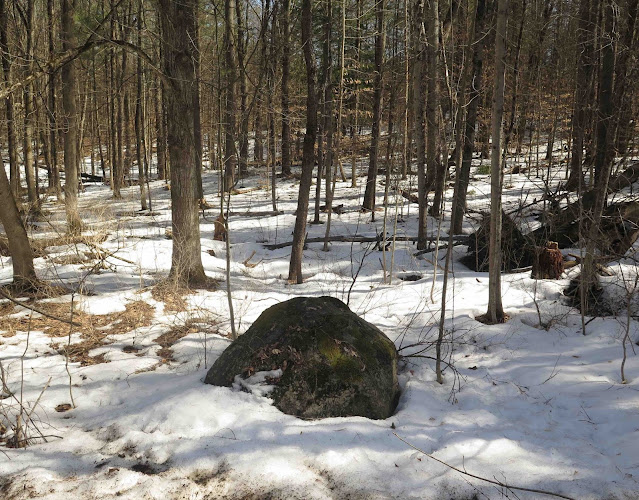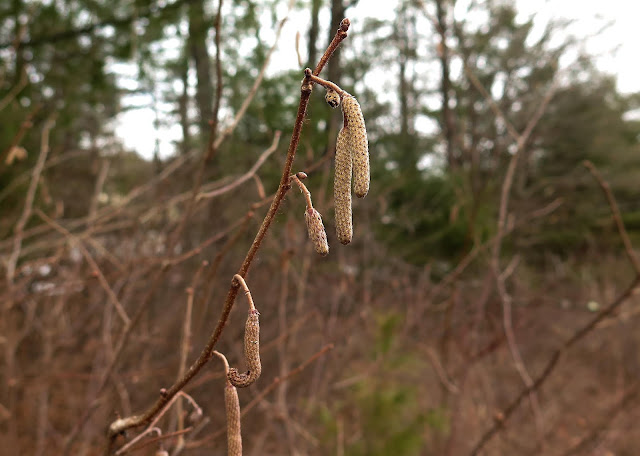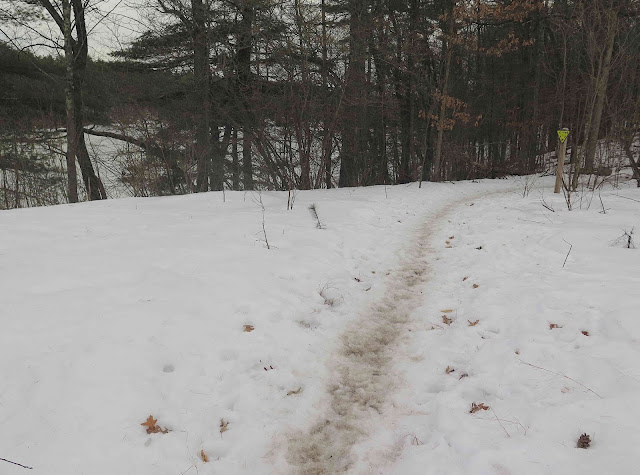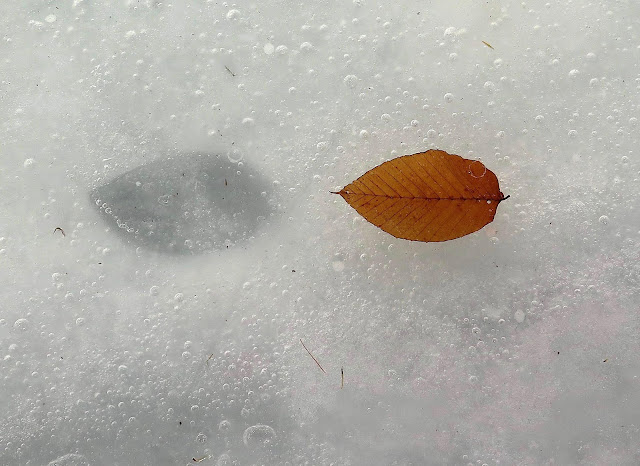At last! A whole string of warm sunny days! This should start springy things happening fast, so I set off these past few days to see what signs of them I could find in the wooded areas near my home in Saratoga Springs.
Saturday, March 20, The Spring Run Trail, Saratoga SpringsWhat better place to celebrate the first day of spring than along a trail called Spring Run? And even though snow still covered the ground in the trailside woods, the south-facing slopes along the Spring Run Creek were wonderfully snow free, with a warm sun crisping the leaves on the forest floor.
I'm not sure that the twigs of Red Osier Dogwood actually intensify their red as spring approaches, or if it's just our winter-weary eyes that are seeking such vivid colors. But they sure were blazing away today, even though their feet were still deep in snow.
I do know that willow branches color up brightly in spring, as the new growth on this small tree demonstrated with its golden bark.
And what a beautiful sight it was, this rainbow of colors in the swamp near the eastern end of the Spring Run Trail: red dogwood, yellow willows, green conifers, blue sky. I don't know if finding a pot of gold here would have delighted me any more than this!
More delight awaited! No one can deny that spring is here for sure when the Pussy Willow fluffs out it silken tufts.
Aha! And what could be a happier find on the first day of spring than the very first FLOWER of spring, this dazzling little Coltsfoot bloom that had pushed up through the cold dead leaves overnight? Yes, I know that Skunk Cabbage usually precedes it in bloom, but the Coltsfoot actually looks like what we think of when we say "flower," like the quintessential blooms that children draw with a yellow crayon. I'm also aware that Coltsfoot is not one of our native wildflowers, but I bet our earliest pollinators won't pass up the feast it offers now, just because this isn't a native. Happy First Day of Spring!
Sunday, March 21, The North Woods at Skidmore College, Saratoga Springs
Among the earliest sounds of spring are the trilling chorus of Spring Peepers and the quacking croaks of Wood Frogs. There's a woodland pond at Skidmore where I hear both frogs in early spring each year. Would I hear them there today? Sadly, I did not. Even though both species often will start their amorous clamor while a bit of ice may still ring their pond, the ice still covered the open water shore to shore, so all was silent. I bet this will change in just a few days, as the forecast calls for more warmth and some rain ahead.
Meanwhile, I noticed the Striped Maple buds where starting to swell. Such elegant buds they are, like ruby-red scepters atop forest-green twigs that are braceleted with pale rings.
It was still way to early to look for hepatica blooms, or even the fur-covered buds. But hey, I could see the ruddy wintered-over leaves of many Sharp-loved Hepatica plants sprawled across some boulders. Why not take a closer look?
Aha! I did find one tiny hepatica bud, just breaking the ground. Another week, if this warmth continues, and we should start seeing these beautiful flowers.
Tuesday, March 23, The Orra Phelps Nature Preserve, Wilton
Today was the warmest day so far, making it all the way to at least 70 degrees (F) under a clear blue sky. Could it possibly have been warm enough for long enough for the Snow Trillium to emerge at Orra Phelps? This wee little trillium has been known to bloom on an upland sun-warmed rise at this preserve while snow still lay in the shaded hollows. And snow did still lie in the hollows today.
And ice still covered the trails with slippery peril. Without ice grippers on my boots, I made my way along by crunching through the softening snow instead of chancing a fall on the icy trail.
In a swale populated by dozens of scarlet spathes of Skunk Cabbage poking up from the moss-covered mud, I was surprised to find very few of the spathes had opened enough to espy any pollen-bearing spadices within. Gosh, but it seemed awfully late for these plants to not yet be in bloom, especially since I had found Skunk Cabbage fully in bloom at other sites nearby.
With the Skunk Cabbage not yet blooming here, I was not surprised to find no trace of Snow Trillium at the location I usually find it. The forest floor was bare where it grows, but not yet warm enough to coax the trilliums awake from their winter sleep. Much of the woods was still quite deep in snow at this preserve, although I could see bare earth now at the base of most of the trees. I have read that sun warming the dark bark of the trunks helps to melt the snow around them.
I decided to avoid those ice-covered trails by returning to my car through the woods, keeping to several stretches of forest floor that were bare of snow. As I neared the banks along Parkhurst Road, I encountered this large patch of blooming yellow flowers. A low stone wall and some moss-covered steps indicated I had come upon the site of a former garden, paved now with hundreds of fully open Winter Aconite. What a floral feast for my winter-weary, flower-famished eyes!
As a native-plant purist, I probably shouldn't have been so happy to find this non-native and possibly invasive flower blooming so profusely at the edge of a nature preserve dedicated to native plants. But oh my, aren't they pretty? And they WERE mostly confined to an area that obviously had been somebody's garden.
More proof of this site's previous function as a private garden was this abundant patch of one more non-native garden plant, called Snow Drops, sharing the space with more of the Winter Aconite. Both of these flowering plants, natives of Europe but not the U.S., are among the earliest flowers to bloom wherever they grow.
As these snow-surrounded flowers indicate, the "winter" part of Winter Aconite is quite well deserved!




















































